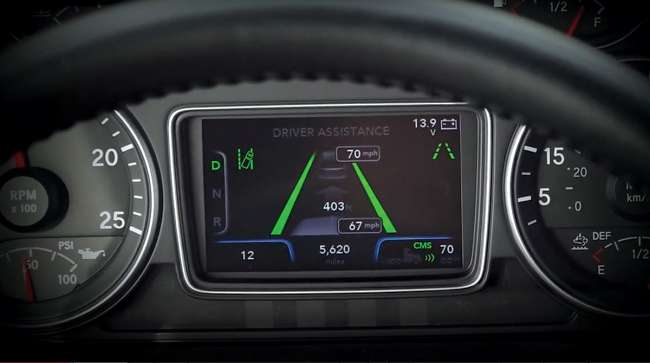Automated Steering Shows Progress

[Stay on top of transportation news: Get TTNews in your inbox.]
What is the outlook for automated steering in big trucks?
“Lane keep” systems have been introduced by some manufacturers in recent years, but technology and marketing experts said work remains to be done.
Lessons have been learned from implementation of technology in passenger cars, but adapting it onto articulated vehicles is a challenge, said Madeline Sullivan, product marketing manager for Volvo Trucks North America .
“With the variety of axle configurations, trailer positioning and GWRs, the software to provide steering assist features becomes very complex,” she said. “Combining that with the variation in performance so many of us have experienced in our own vehicles, I think fleets are rightfully cautious of this technology and how their drivers would respond.”

Sullivan
Sullivan added that the industry is a long way from standardization on steer assist technology.
“As another road user, I would personally feel better if more Class 8 vehicles had steering assist features; but on the development side, I know we don’t want the technology out there until it’s mature and ready for the application,” she said, noting that these systems continue to be refined and are even pushed by the investments in technology to enable autonomous transport.
“We are much closer today to those being standard than we were just a few years ago,” Sullivan said.
TJ Thomas, director of marketing and customer solutions for Bendix Commercial Vehicle Systems, said that integrating lane keep assist or lane centering technologies are highly integrated into vehicle architecture, and integrating supplier systems into a vehicle “takes time, testing, and alignment by all involved.”
Further integration with vehicle systems and supplier systems is a possible path for more automatic directional control of the vehicle, Thomas said.
“As sensor capabilities continue to enhance what systems know about what’s going on with the vehicle and things around it,” he added, “more decisions can be made by onboard systems to further mitigate accidents and continue to support fleet safety cultures.”

Treinen
Detroit Assurance’s Active Lane Assist (ALA) system was introduced to the market in 2019 with the Freightliner Cascadia. It features an electric steering motor to provide automatic lateral steering in various situations, said Greg Treinen, vice president of on-highway market development at DTNA.
Treinen said ALA employs the Detroit Assurance camera to detect lane markers, correcting lane drifting through Lane Departure Protection (LDP) and helping to keep the truck centered with Lane Keep Assist.
The fifth-generation Cascadia in 2025, premiered at American Trucking Associations’ Management Conference & Exhibition last October, will be equipped with the second generation of ALA, known as ALA2, designed to mitigate out-of-lane accidents through Lane Change Assist (LCA).
“This feature actively steers the driver back into their lane if a lane change is attempted into an already occupied lane, even if the turn signal is activated,” Treinen said.
Both iterations of the ALA technology also decrease necessary steering force to reduce stress on drivers’ arms, necks and shoulders, providing driver comfort, Treinen said, noting these systems enhance the driving experience by reducing vibrations, returning the steering wheel to center, assisting with crosswinds and making yard maneuvering much easier.
“They can even provide support in the event of a blown tire,” Treinen said.
Similarly, torque overlay steering is gaining traction in vocational applications as it reduces steering effort and driver fatigue on the job site and while maneuvering, Kenworth said in an email statement to Transport Topics. In general, advancement in ADAS capabilities will continue to accelerate and there will be more standardization as regulations, such as an expected AEB mandate, go into effect, Kenworth said.
ZF announced in July that it expanded its cubiX vehicle motion control to commercial vehicles.
Want more news? Listen to today's daily briefing above or go here for more info
“With the emergence of new electrical and electronic vehicle technologies, all vehicle actuators including brakes, driveline and steering can be managed cohesively through centralized control software,” ZF said in a news release.
Manufacturers must break customers from traditional assistance systems, said Sudhive Nair, ZF North America product line leader for ADAS, brake controls, wheel end and steering.
“We are in conversation with truck drivers, trying to understand their pain points. The manufacturer is also talking to fleet owners, Nair said. “We let them experience the technologies firsthand, and doing that gives them the ability to activate and deactivate functions as per their need.”

